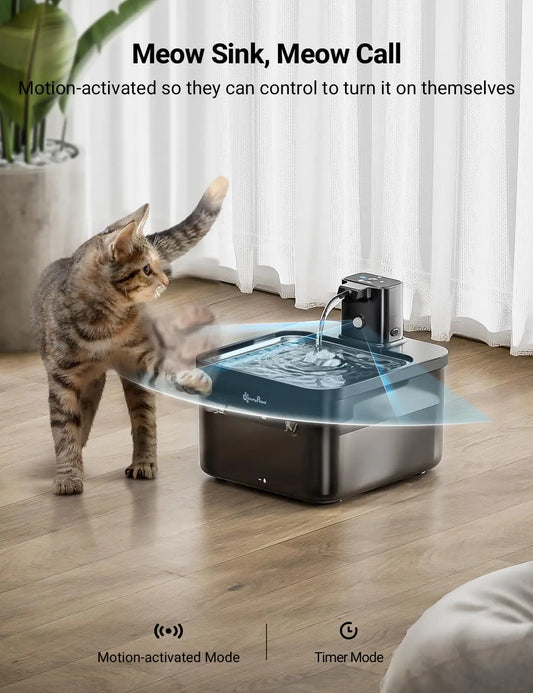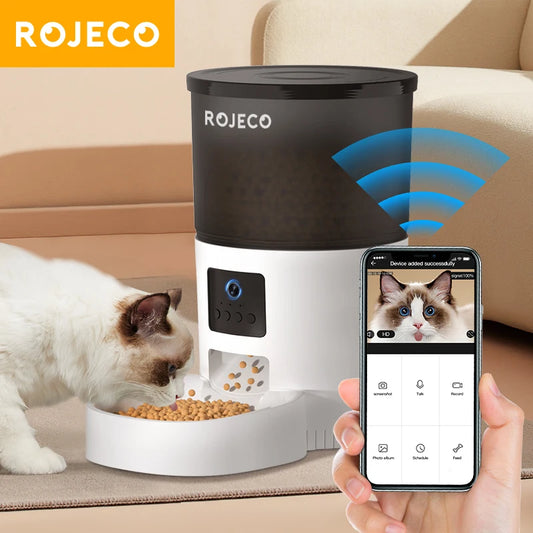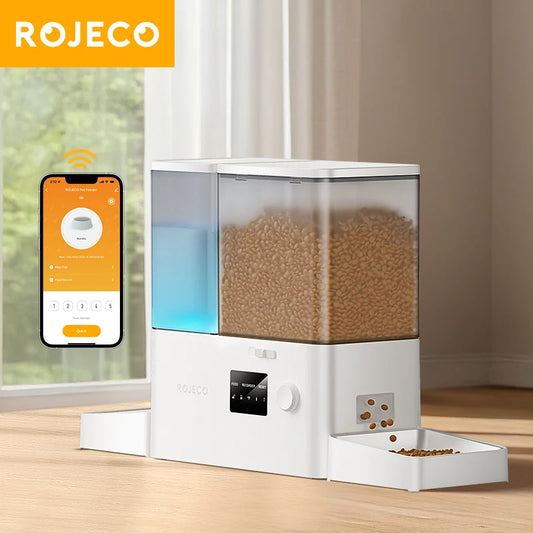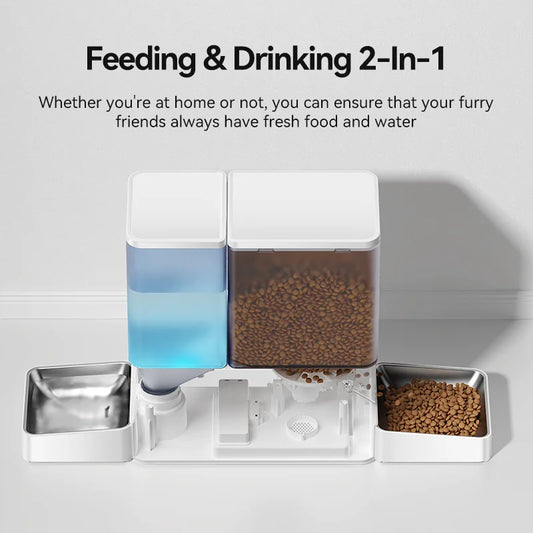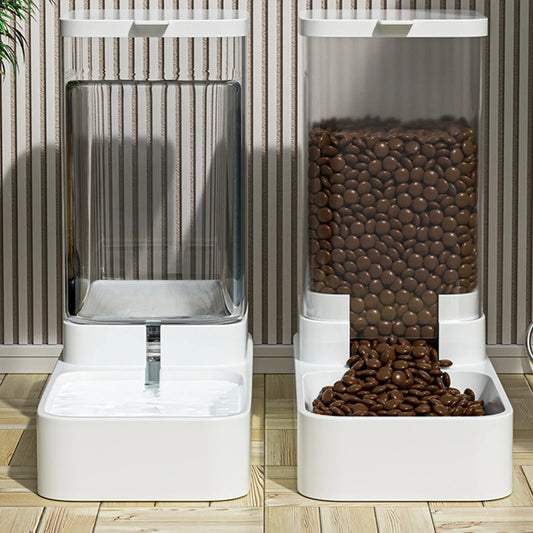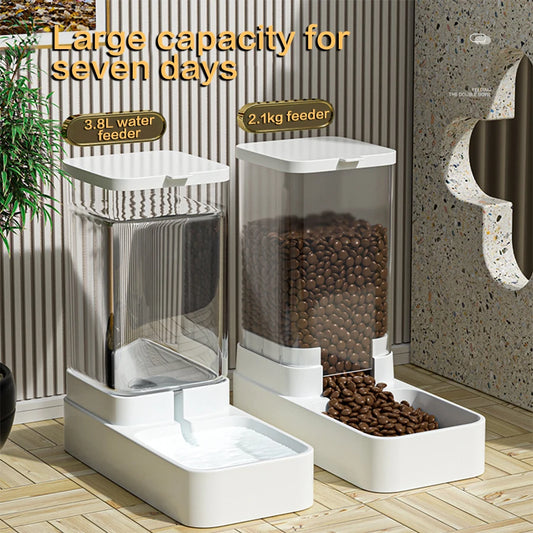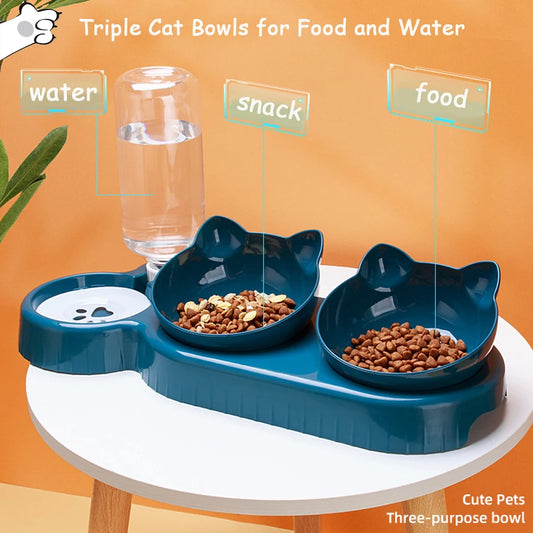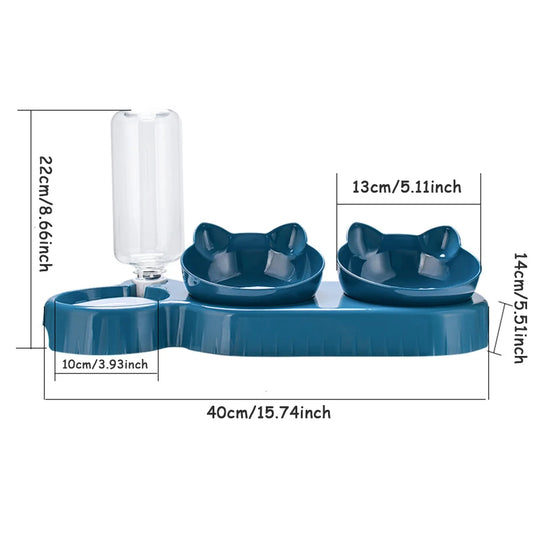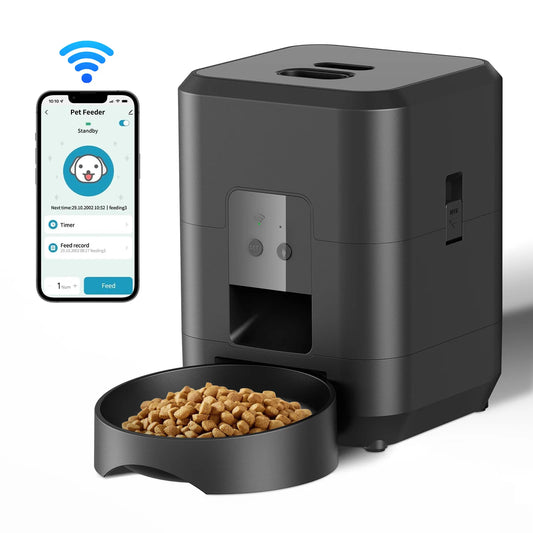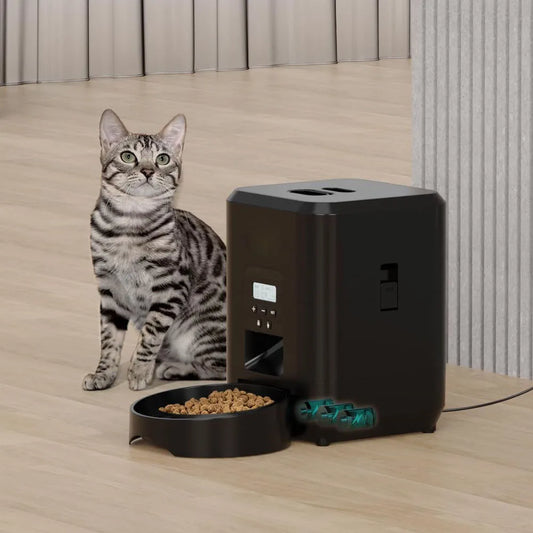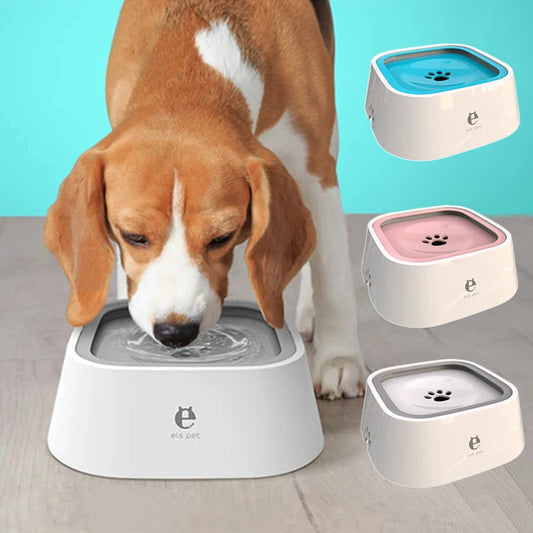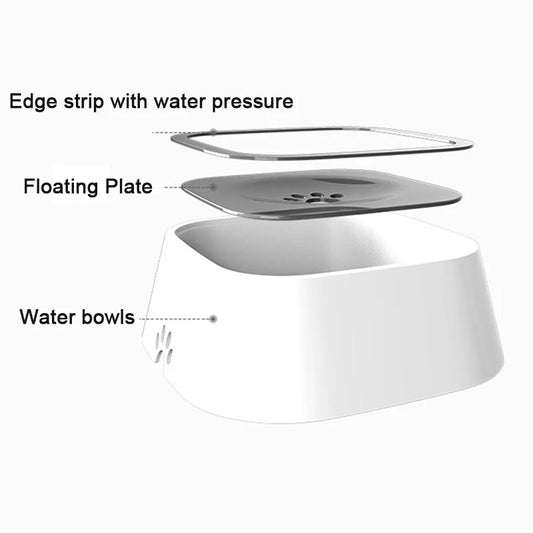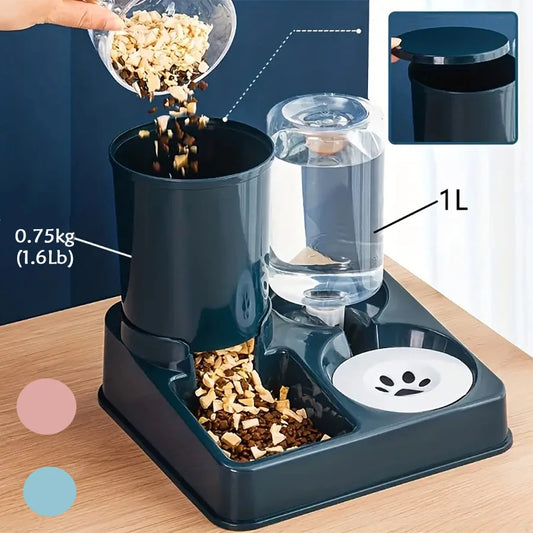Collection: Automatic Cat Feeder
Automatic Cat Feeders: Hassle-Free Mealtime for Your Feline Friend
Looking for reliable automatic cat feeders to keep your kitty happy and fed? Our online store offers a variety of automatic cat feeders with programmable timers, portion control, and easy-to-clean designs. Perfect for busy pet parents, these feeders ensure your cat enjoys perfectly timed and portioned meals every day. Shop our selection of automatic cat feeders today for a convenient feeding solution!

Shop by Category
-
Automatic Stainless Steel Cat Water Fountain
Free ShippingRegular price $98.95 AUDRegular priceUnit price / perSale price$159.95 AUD$98.95 AUDSale -
Automatic Cat Feeder With Camera Video Cat Food Dispenser
Free ShippingRegular price $145.95 AUDRegular priceUnit price / perSale price$203.95 AUD$145.95 AUDSale -
8.5L Automatic Pet Feeder With Gravity Water Fountain 2-in-1 WiFi Remote Control
Free ShippingRegular price $143.95 AUDRegular priceUnit price / perSale price$200.95 AUD$143.95 AUDSale -
Automatic Gravity Food or Water Dispenser for Cats and Dogs
Free ShippingRegular price From $31.95 AUDRegular priceUnit price / perSale price$41.95 AUDFrom $31.95 AUDSale -
Pet Automatic Timing Feeder Bowl
Free ShippingRegular price From $43.95 AUDRegular priceUnit price / perSale price$56.95 AUDFrom $43.95 AUDSale -
Automatic Feeder and Drinker Bowl
Free ShippingRegular price From $39.95 AUDRegular priceUnit price / perSale price$51.95 AUDFrom $39.95 AUDSale -
Automatic Water or Food Dispenser for Dogs and Cats
Free ShippingRegular price From $26.95 AUDRegular priceUnit price / perSale price$37.95 AUDFrom $26.95 AUDSale -
Dog Food and Water Bowl
Free ShippingRegular price $23.95 AUDRegular priceUnit price / perSale price$33.95 AUD$23.95 AUDSale -
Automatic Smart Pet Feeder
Free ShippingRegular price From $79.95 AUDRegular priceUnit price / perSale price$128.95 AUDFrom $79.95 AUDSale -
Automatic Dog Water Bowl
Free ShippingRegular price From $33.95 AUDRegular priceUnit price / perSale price$47.95 AUDFrom $33.95 AUDSale -
Automatic Dog Food Feeder
Free ShippingRegular price From $35.95 AUDRegular priceUnit price / perSale price$50.95 AUDFrom $35.95 AUDSale
Why Cat Owners Love Our Automatic Cat Feeder?
An automatic cat feeder is more than just a convenient pet accessory—it’s an essential tool for ensuring your cat stays well-fed, healthy, and stress-free, even when you're not home. Here’s why our automatic cat feeders are the perfect choice for busy pet parents:
🐾 Consistent & Timely Feeding – Automatically dispenses the right portion at scheduled times, keeping your cat’s feeding routine on track.
🐾 Customizable Meal Portions – Adjust portion sizes to match your cat’s dietary needs and prevent overeating.
🐾 Fresh & Hygienic Food Storage – Airtight design keeps kibble fresh, crisp, and free from pests or contamination.
🐾 Smart & Programmable Settings – Set up multiple meal schedules with an easy-to-use control panel or mobile app.
🐾 Suitable for All Cat Breeds – Whether you have a small kitten or a large adult cat, our feeders cater to every breed.
🐾 Prevents Overeating & Obesity – Controlled feeding ensures your cat maintains a healthy weight and avoids binge eating.
🐾 Battery & Power Adapter Options – Works with both power adapter and battery backup for uninterrupted feeding.
🐾 Easy to Clean & Maintain – Detachable parts make cleaning effortless, keeping your cat’s feeding area hygienic.
🐾 Free Worldwide Shipping – Get your automatic cat feeder delivered anywhere with no extra shipping fees.
🐾 Trusted by Cat Owners Worldwide – Highly rated for reliability, ease of use, and pet-friendly design.
🐾 Great Value for Money – A perfect mix of convenience, portion control, and peace of mind for pet parents.
With our automatic cat feeder, you can ensure your cat stays happy, healthy, and well-fed—even when you're away! 🐱💖
Frequently Asked Questions for Automatic Cat Feeders
If you're looking for the best automatic cat feeder, our online pet supplies store has everything you need to keep your feline well-fed, healthy, and happy. Here’s why we are your best choice for automatic cat feeders in Australia!
What is the best automatic cat feeder to buy in Australia?
At our store, we offer a range of top-rated automatic cat feeders, perfect for every type of pet parent. Whether you're looking for a Wi-Fi-controlled feeder, a programmable timer feeder, or a model that dispenses wet food, we have the best options for your needs. Our top sellers include:
✔️ Smart Wi-Fi Cat Feeder – Control feeding from your phone.
✔️ Dual Bowl Feeder for Multiple Cats – Ensures fair food distribution.
✔️ Automatic Wet & Dry Food Feeder – Keeps food fresh and portioned correctly.
Where can I buy a reliable automatic cat feeder in Australia?
You can purchase high-quality automatic cat feeders directly from our online store! We offer:
🚚 Fast shipping Australia-wide
💰 Competitive prices
✅ Trusted brands with top customer ratings
🔄 Hassle-free returns & warranty on all products
Order from us today and enjoy exclusive discounts and free shipping on select models!
How much does a high-quality automatic cat feeder cost?
Our automatic cat feeders are available at different price points to suit every budget:
💲 Basic Timer Feeders: Starting from $20 AUD
💲 Mid-Range Programmable Feeders: $45.95 - $55.95
💲 Premium Wi-Fi Smart Feeders: $72.95 - $86.95
We also offer seasonal discounts and bundle deals, so be sure to check out our latest offers!
Which automatic cat feeder is best for multiple cats?
For multi-cat households, we offer dual-bowl automatic feeders and large-capacity dispensers to ensure fair portioning. Our top picks include:
🐾 Split Tray Feeders – Even food distribution for two cats.
🐾 Large Capacity Feeders (5L+) – Stores enough food for multiple pets.
🐾 Microchip-Activated Feeders – Ensures each pet gets the right food.
Check our multi-pet collection for the perfect solution for your cats!
What features should I look for in an automatic cat feeder?
Our store offers feeders with all the must-have features, including:
✔️ Programmable portion control to prevent overfeeding.
✔️ Smart Wi-Fi app control for remote feeding.
✔️ Battery backup for power outage protection.
✔️ Durable, easy-to-clean designs for hygiene.
Explore our feature-packed models and find the best fit for your cat!
Do automatic cat feeders come with Wi-Fi and app control?
Yes! Our smart automatic cat feeders allow you to:
📱 Control feeding schedules via a mobile app
📱 Monitor food levels remotely
📱 Set portion sizes from anywhere
📱 Receive notifications when food is dispensed
With our Wi-Fi-enabled automatic feeders, you’ll never have to worry about feeding times again!
Which automatic cat feeder has the best battery backup in case of power outages?
For reliable feeding even during power cuts, we offer:
🔋 Dual Power Feeders – Works with both plug-in power and batteries.
🔋 Long-Lasting Battery Feeders – Runs for weeks without needing new batteries.
🔋 Power Failure Alerts – Sends notifications if the feeder loses power.
Our best-selling battery backup feeders ensure your cat never misses a meal!
What is the most durable and long-lasting automatic cat feeder?
Our premium automatic cat feeders are built to last with:
🛠️ High-quality BPA-free materials for pet safety.
🛠️ Anti-jam technology to prevent food blockages.
🛠️ Tough, secure lids to stop cats from breaking in.
🛠️ Heavy-duty, tip-resistant designs for stability.
Check out our best-rated durable feeders, perfect for long-term use!
Can I set different feeding schedules for multiple cats in the same household?
Yes! We offer programmable automatic cat feeders that allow you to:
⏰ Set different portion sizes for each meal.
🐾 Assign feeding times for different pets using microchip or RFID tags.
🔄 Use multiple feeding compartments to ensure fair distribution.
Our smart automatic feeders give you full control over meal portions for each pet!
Why Buy From Us?
🐾 Premium quality automatic cat feeders for all needs.
🚚 Fast shipping Australia-wide with free delivery on select models.
✅ Trusted by thousands of pet owners with 5-star reviews.
💰 Exclusive deals, discounts, and bundle offers.
🔄 Easy returns, warranty, and excellent customer support.
🛒 Shop Now & Make Mealtime Stress-Free for Your Cat!
Blog posts
View all-

Meet the Norwegian Lundehund: Australia’s Rares...
The Norwegian Lundehund stands as one of the most distinctive and seldom-seen dog breeds in Australia. With its roots stretching back to the rugged coastal cliffs of Norway, this breed...
Meet the Norwegian Lundehund: Australia’s Rares...
The Norwegian Lundehund stands as one of the most distinctive and seldom-seen dog breeds in Australia. With its roots stretching back to the rugged coastal cliffs of Norway, this breed was once relied upon by Scandinavian fishermen for its remarkable ability to scale steep rocks and retrieve puffins—a vital source of food. What sets the Lundehund apart from every other breed is its remarkable anatomical adaptations: six toes on each foot, double-jointed flexibility, and the capacity to close its ears to protect against water and debris.
-

Best Collars for Dogs That Pull: Vet-Approved P...
Key Takeaways Dogs that pull on the lead may suffer from neck strain or behavioural issues if the wrong collar is used. Vet-approved collars like martingales and head halters offer...
Best Collars for Dogs That Pull: Vet-Approved P...
Key Takeaways Dogs that pull on the lead may suffer from neck strain or behavioural issues if the wrong collar is used. Vet-approved collars like martingales and head halters offer more humane and effective control. Tools alone don’t solve pulling — they must be used with proper training and positive reinforcement. Australian pet owners should be aware of state-specific laws around the use of corrective collars like prong or shock collars. Choosing the right collar depends on your dog’s size, strength, and temperament — and not all collars work for every dog. This guide helps you understand which collars are safest, most effective, and recommended by Australian vets and trainers. Introduction Pulling on the lead is one of the most common complaints from dog owners. Whether it’s a young puppy excited to explore the world or a large dog that simply doesn’t know how strong it is, leash pulling can make daily walks stressful — even dangerous. For Australian pet owners, especially those walking in busy suburbs, parks, or bushland trails, having control of your dog is essential. But the solution isn't just about brute strength — it’s about choosing the right tools that promote comfort, safety, and better behaviour. In this article, we explore the best collars for dogs that pull — those recommended by veterinarians and animal behaviour experts — and explain how to use them effectively. We'll also guide you through what to avoid, what the law says in Australia, and how to pair the right collar with proven training techniques. Why Dogs Pull on the Leash Understanding why your dog pulls is the first step in fixing it. Contrary to popular belief, pulling isn’t necessarily about dominance or defiance. It’s often more about excitement, poor leash manners, or a simple case of what gets rewarded, gets repeated. Common Reasons Dogs Pull: Excitement or overstimulation: New smells, sights, and sounds make walks thrilling. Lack of early leash training: Dogs not trained as pups may never learn proper walking etiquette. Reinforced pulling: If pulling gets your dog where it wants to go, it learns to repeat it. Breed traits: Working breeds like Huskies, Staffies, and Kelpies often pull more due to strong drive. Infrequent walking: Dogs that only walk occasionally tend to be more energetic and harder to manage on leash. 🗨️ “Dogs pull because it works. If they get to a smell or a person faster, the behaviour is reinforced.” — Dr. Kate Mornement, Australian Animal Behaviourist Risks of Using the Wrong Collar on a Dog That Pulls Using an inappropriate collar on a pulling dog isn’t just ineffective — it can be harmful. Pulling with a regular flat collar or choke chain can result in long-term damage or distress. Potential Risks Include: Neck strain and tracheal injury: Especially dangerous for small breeds and brachycephalic dogs. Increased anxiety or aggression: Painful collars can create negative associations with walking. Escape risk: Some collars are easier for dogs to slip out of when pulling. Legal implications: Certain collars, like prong and shock collars, are regulated or banned in parts of Australia. ⚠️ According to the RSPCA, aversive training tools like choke or prong collars “can cause pain and fear, and may lead to increased aggression and behavioural issues.” (source). What Vets Recommend: Principles Behind Safe Collar Use Veterinarians and animal behaviourists emphasise humane training tools that promote trust and reduce stress. This aligns with what’s known as "force-free training", which avoids pain or intimidation. Key Principles Vets Emphasise: Use collars that minimise pressure on the neck. Ensure the collar fits properly — not too tight, not too loose. Choose materials that don’t cause rubbing or irritation. Combine tools with positive reinforcement (treats, praise). Transition to simpler collars as the dog becomes better trained. 🗨️ “The most effective tools are the ones that make walking a positive experience for both dog and owner.” — Dr. Cam Day, Veterinary Behaviourist (Australia) Top Vet-Approved Collars for Dogs That Pull Not all collars are created equal. Below are the top types of collars (and alternatives) that vets and trainers frequently recommend. 1. Martingale Collars Also called limited-slip collars, martingales tighten slightly when the dog pulls — but without the harsh “choking” action of a traditional slip lead. Best For: Dogs with narrow heads (e.g., Greyhounds, Whippets) Dogs that slip out of flat collars Pros: Offers gentle correction Prevents slipping out Recommended by behaviourists Cons: Still applies pressure to neck — not suitable for heavy pullers ✅ RSPCA Australia supports martingale collars as a safer option for dogs that pull, especially when used alongside training. 2. Head Collars (e.g., Halti, Gentle Leader) These collars fit around the dog's snout and gently guide the head — and therefore the body — making pulling less effective. Best For: Large, strong dogs Reactive dogs needing more directional control Pros: Immediate reduction in pulling Helps prevent lunging Cons: Some dogs resist wearing it at first Requires acclimation and proper fit 🗨️ “Used correctly, head halters can be highly effective. But misuse can cause neck strain, so training is essential.” — Dr. Jo Righetti, Pet Behaviour Consultant 3. Front-Clip Harnesses (Not collars, but often preferred) Harnesses like the PetSafe Easy Walk or Rogz Control Harness offer an alternative by redistributing pressure across the dog’s chest rather than its neck. Best For: Dogs that pull heavily or have respiratory issues Owners who struggle with leash strength Pros: Safer than collars for heavy pullers Reduces pulling through redirection Popular in Australian obedience circles Cons: Can cause rubbing if poorly fitted May not deter very determined pullers 🐾 Note: In many Australian vet clinics, front-clip harnesses are the go-to recommendation for large breeds and rescue dogs. 4. Flat Collars (for well-trained dogs only) Simple and comfortable, these collars are suitable once your dog is trained to walk calmly. Best For: Dogs with reliable leash manners Everyday ID tag wear Caution: Never rely on a flat collar alone if your dog is still learning not to pull. Collars to Avoid for Pulling Dogs Some collar types are outdated, inhumane, or outright dangerous — especially when used incorrectly. 1. Choke Chains Designed to tighten around the neck when the dog pulls. Once popular, now widely criticised. ❌ “We do not recommend choke chains under any circumstances.” — Australian Veterinary Association 2. Prong Collars Metal collars with inward-facing prongs that dig into the skin when pulled. Banned in Victoria and under review in other states. May cause behavioural fallout, fear, and aggression. ⚠️ The RSPCA and Pet Industry Association of Australia oppose their use. 3. Shock Collars (E-collars) These collars deliver electric stimulation to “correct” behaviour. Legal status varies across Australia (banned in some states). Not recommended by any major Australian veterinary body. “Using pain to control behaviour is not only unethical — it doesn’t work long-term.” — Dr. Katrina Warren, TV vet and author Choosing the Right Collar: What to Consider Every dog is different, and the best collar for one may not be suitable for another. To select the right collar for a dog that pulls, you’ll need to assess their physical characteristics, behaviour, and environment. Factors to Consider: Size and Breed Smaller breeds (e.g., Maltese, Cavoodles) may need softer materials and minimal pressure around the neck. Larger or working breeds (e.g., Kelpies, Labradors) may benefit from front-clip harnesses or head collars due to stronger pulling. Pulling Intensity Mild pullers might do well with a martingale. Strong pullers may require a head halter or harness for safe control. Temperament Anxious or nervous dogs may become reactive with restrictive collars. Confident dogs may test limits and need something more secure. Walking Environment Suburban footpaths vs bush trails vs beach walks—some collars handle moisture or rough terrain better. Training Level Dogs early in training need more control. Trained dogs may graduate to a padded flat collar. How to Fit a Collar Properly Poor fit is a common issue that can make even the safest collar ineffective—or harmful. General Fitting Guidelines: The 2-Finger Rule: You should be able to slide two fingers comfortably between the collar and your dog’s neck. Measure Before You Buy: Use a soft measuring tape to measure your dog’s neck at its base. Watch for Signs of Discomfort: Rubbing or hair loss Coughing or gagging on walks Frequent pawing at the collar Slipping out or constant re-adjustment Tips for Head Collars and Harnesses: Ensure the nose loop (for head collars) isn’t too tight — your dog should be able to open their mouth. Chest harnesses should sit snugly on the breastbone, not press against the armpits. 🗨️ “A poor-fitting collar can lead to discomfort, skin damage, or worse — especially for dogs that pull hard.” — Dr. Melissa Meehan, Vet & Behavioural Consultant Training Tips for Dogs That Pull A collar is just a tool. To see lasting results, pair it with consistent training that encourages your dog to walk calmly on a lead. Foundational Training Techniques: Reward-Based Walking: Reward your dog with treats or praise when they walk beside you without pulling. Stop walking immediately when they pull — teach them pulling gets them nowhere. Redirection: Use a cue like “Let’s go!” and change direction often to keep your dog focused. Short, Frequent Walks: Consistency is better than duration. Several short walks help reinforce good habits. Engage a Certified Trainer: Seek a professional who uses positive reinforcement methods. Avoid trainers who rely on punishment-based tools like prong or shock collars. 🔗 For trainer directories, visit: Delta Institute (Australia) or PPGA Australian Perspective: What Local Vets and Laws Say Australia has some of the strictest animal welfare laws in the world, particularly concerning aversive training tools. Legal Status of Collars in Australia (as of 2025): Prong Collars: Banned in VIC; under review in NSW and ACT. Shock Collars: Banned in parts of SA and WA. Choke Chains: Not illegal but strongly discouraged by vets and the RSPCA. Martingale, Head Collars, and Front-Clip Harnesses: Fully legal and recommended. Trusted Brands Available in Australia: Rogz Utility Control Collar (available at PetCareShed) Halti Optifit Headcollar PetSafe Easy Walk Harness Black Dog Wear Training Gear (Australian-made) 🗨️ “Responsible collar use means choosing what’s humane and effective. Australia leads the way with a shift to force-free training methods.” — Association of Pet Dog Trainers Australia Expert Commentary and Vet Insights Multiple Australian professionals advocate for smarter collar choices based on evidence, not tradition. 🗨️ “We’re seeing a move away from force-based collars in vet clinics. Behavioural injuries are real, and prevention starts with the right gear.”— Dr. Bronwyn Hodgson, Sydney Animal Hospital 🗨️ “Using a collar that aligns with how a dog thinks and learns is more powerful than forcing control.”— Stephanie McColl, Delta Accredited Trainer, Melbourne 🗨️ “Insurance claims related to neck injuries are rising in dogs that wear outdated collars. Choose gear that protects, not punishes.”— PetSure Australia 2024 Industry Report Related Products from PetCareShed At PetCareShed, we stock safe and trusted collars recommended by vets and trainers: Rogz Control Collar with Locking Buckle Halti Headcollars and Training Leads PetSafe Easy Walk Harness – Front Clip Martingale Training Collars in Soft Nylon Comfort-Fit Flat Collars for Trained Dogs ✅ Free shipping across Australia💬 Need help choosing? Contact our product specialists. Frequently Asked Questions Are no-pull collars safe for puppies? Yes, many are — especially front-clip harnesses and head halters. Always introduce them slowly and pair with positive training. What if my dog still pulls with a no-pull collar? Consider a professional trainer. No collar will work without consistent reinforcement and behaviour shaping. Can I use a training collar with a retractable leash? It’s not recommended. Retractable leashes encourage pulling and reduce your control — especially with corrective tools. How long does it take to train a dog to stop pulling? This depends on age, breed, and consistency. Some dogs respond in days, others may take weeks to months of practice. Are head halters cruel or uncomfortable? Not when fitted properly. They’re like a horse halter — they guide, not punish. Always supervise use.
-

Abyssinian Cats: Active and Intelligent Felines
The Abyssinian cat is a breed that captivates hearts and minds alike, known for its remarkable intelligence, boundless energy, and striking appearance. Often described as the "athlete" of the feline...
Abyssinian Cats: Active and Intelligent Felines
The Abyssinian cat is a breed that captivates hearts and minds alike, known for its remarkable intelligence, boundless energy, and striking appearance. Often described as the "athlete" of the feline world, the Abyssinian is more than just a pretty face; it is a companion that brings adventure, joy, and a touch of the exotic into the homes of Australian pet lovers.


